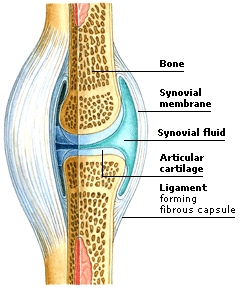by Dr. Ekta Chanchani
What is a Joint ?
A joint is a junction of two or more bones. It gives movement and mobility in our various day to day activities like walking, running, cycling, sitting, getting up (arising) etc.
Types of Joints:
There are three main types of joints in our body depending on the type of material present between the two joining bones.
- Fibrous Joints : The two bones are separated by a thin fibrous tissue. Adjacent bones are thus attached firmly together. So, no movement is possible between the two joining bones.
Example, cranial bones in the skull are joined by fibrous joint. - Fibrocartilagenous Joints : The two bones are separated by a fibrocartilage which is flexible so a little movement is possible between the bones.
Example, in the spine, the intervertebral discs and also in pubic symphysis the two hip bones are joined by fibrocartilagenous joints. - Synovial Joints : These joints are most mobile of all joints. Gross movement is possible in these joints because the two joining bones are separated by a joint space containing synovial fluid. Most of the joints we use in our day to day life are synovial joints. Examples the knee, elbow, hip, ankle etc. are all synovial joints.

Capsule : – The ends of the joining bones are covered by a fibrous covering known as joint capsule. It makes the joint compact and strong and also encloses the joint cavity which is filled with synovial fluid.
Hyaline Cartilage : – The free ends of the bones are covered by hyaline cartilage. It is not as hard as the bone and therefore it is not seen on X-ray. It provides two smooth apposing surfaces which have very little friction between them for easy articulation (joining). It also provides an elastic tissue which gets deformed easily so that load from one bone gets evenly distributed on to the other bone. This prevents erosion during motion and loading. Sometimes additional fibrocartilage pads divide the joint cavity completely (Discs, in the spine) or partially (Menisci, in the knee).
Hyaline cartilage does not have its own blood supply and thus gets its nourishment from synovial fluid present around it.
Types of Synovial Joints
Synovial Membrane :- This membrane is present on the inner side of capsule and on the ends of bone present inside the capsule. It is made up of cells and elastic tissue. It secretes the synovial fluid. It has a very rich blood supply.
Synovial Fluid :- It fills up the joint space and is useful because it provides lubrication to the joint and thereby reduces the friction between the two bones.
Ligaments :- They are thickened portions of the capsule or separate fibrous structures. They help to make the joint strong.
Bursae :- They are sacs which are filled with fluid. They are important because they allow easy and smooth movement between the two bones.
Enthesis :- The site of firm attachment of fibrous structures (tendon, ligament, capsule) on to the bone is called enthesis. This site is often inflamed through mechanical trauma or are involved in inflammatory disease, e.g. inflammatory arthritis or spondyloarthropathies.
Muscles :- The muscles are important for active movement of a joint. Contraction of one muscle (or a group of muscles) is always accompanied by relaxation of the opposite muscles, thus balancing and giving power to the joint movement.
Tendons :- They act as bridges between muscle and bone. They help in motion and also help to make the joint stable.
The range of movement and stability of the individual joints depends on –
- Shape of the joining surfaces.
- Strength of the capsule.
- Ligaments.
- Muscles acting across the joint.
- Presence of adjacent structures.
It is important to understand the structure of a joint because different types of arthritis involve the different types & different parts of a joint.
For example, in rheumatoid arthritis, the synovial membrane gets inflamed causing pain. Cells get collected on the membrane forming a structure known as PANNUS. This pannus causes erosion of cartilage & bone, leading to deformities.
In seronegative arthritis, including infective arthritis, reactive arthritis and degenerative arthritis, including osteoarthritis, and spondyloarthritis, the fibrocartilagenous joints and fibrocartilage (hyaline cartilage) of the synovial joint is affected.
In degenerative arthritis, erosion of the cartilage occurs, reducing the joint space & thereby increasing the friction between the two bones during movement causing pain.
